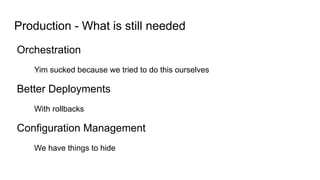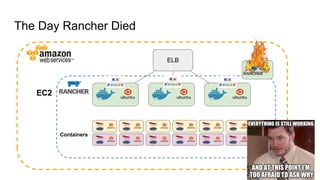2016 - Easing Your Way Into Docker: Lessons From a Journey to Production
- 1. Docker at SpareFoot Lessons From a Journey to Production DevOps Days Austin May 3, 2016
- 2. Who am I? Steve Woodruff ❏ Director of DevOps at SpareFoot implementing CI/CD ❏ Spent 10+ years at Motorola doing embedded development (C, C++) ❏ Spent 5 years at IBM as a sys admin in a large server farm (Linux, AIX, Solaris) [email protected] Twitter: @sjwoodr GitHub: sjwoodr
- 3. ● Think Hotels.com for self storage* ● All infrastructure in AWS ● 40 Developers on 7 Teams ○ Continuous Delivery ● Docker in production since 2014 *This kind of storage:
- 4. The Beginning: SpareFoot + Docker Hackathon! Docker + Fig (now compose) allowed us to run production architecture locally.
- 5. Yim - Call Center Application Used exclusively by our call center Chrome ONLY Node version n+1 React + Flux Vers. n +1 Vers. n +1 Vers. n
- 6. Yim - Call Center Application Used exclusively by our call center Chrome ONLY Node version n+1 React + Flux Vers. n +1 Vers. n +1 Vers. n
- 7. CI and deployments Janky shell scripts… slow builds, etc… Used Bamboo to build images feature branches were built/deployed to Dev master branch was built/deployed to Staging Dynamically created custom container start script Tried to auto-detect when the containers started to begin post-deploy test Build times were rather long Spent an awful long time doing docker push (to our registry) and docker pull (on the target hosts)
- 8. Ok, so Docker feels like the a solution … and we kind of know how to do this. But.... Continuous Integration / Delivery? ○ Docker Registry ○ Bamboo ○ Deployments ● Host Volumes and Port Forwarding rules? ○ Not saved with the source code ● Get Docker to run in local, dev, staging, and production environments? ○ Configuration?
- 9. Docker in Production (technically)! We had 2 load balanced EC2 instances running a node app. ELB 443 3000 3000
- 10. Docker in Production (technically)! We had 2 load balanced EC2 instances running a node app. Now we have 2 load balanced EC2 instances running docker containers that run a node app! ELB 443 3000 3000 ELB App 1 App 1 3000 3000 443
- 11. Docker in Production (technically)! ELB ELB App 1 App 1 We had 2 load balanced EC2 instances running a node app. Now we have 2 load balanced EC2 instances running docker containers that run a node app! NEW443 3000 3000 3000 3000 443
- 12. Yim: Trouble in Docker Paradise Hosting our own Docker registry was a bad idea Stability was a problem No level of access control on the registry itself Mimicking servers - 1 container per host. Need orchestration please! Amazon Linux AMI -> old version of Docker… doh! Docker push/pull to/from registry was very slow build - push to registry deploy - pull from registry to each host, serially Performance was fine…. But stability was the issue This internal-facing nodejs app was moved to a pair of EC2 instances and out of Docker after about 4 months of pain and suffering
- 13. Yim: Lessons Learned We need orchestration Rolling our own docker deployments was confusing to OPS and to the Dev team Our own docker registry is a bad idea Stability was a problem No level of access control on the registry itself Our S3 backend would grow by several GB per month with no automated cleanup No easy way to rollback failed deploys Just fix it and deploy again... All this culminated in a poor build process and affected CI velocity Longer builds, longer deploys, no real gain
- 14. Like everyone else.... ...we were “deconstructing the monolith” Application Monolithic Library Data
- 15. Like everyone else.... ...we were “deconstructing the monolith” Application REST API Data Microservice REST API Data Microservice REST API Data Microservice REST API Data Microservice API Gateway
- 16. A Better Docker Registry With Yim we learned that rolling our own Registry was a bad idea. Limited Access Control We have to maintain it
- 17. Let’s try Quay... Has Access Control Robots, yusss! We don’t have to maintain it
- 18. We’ve learned some things... ● Easier than we thought ● Quay was the glue we needed ○ Use an off the shelf solution. ○ We like Quay.io ● Bolting on to our existing CI pipeline worked really well. ○ Developers didn’t have to learn new process ○ Microservice consumers can pull tagged versions ○ We can automate tests against all versions Now we talk containers from local -> dev -> staging but NOT in production.
- 20. Production - What is still needed Orchestration Yim sucked because we tried to do this ourselves Better Deployments With rollbacks Configuration Management We have things to hide
- 23. Production - Software Selection Choosing orchestration software / container service in early 2015 StackEngine Lacked docker-compose support Kubernetes PhD Required Mesosphere Nice, but slow to deploy EC2 Container Service Lacked docker-compose support and custom AMIs Tutum (now Docker Cloud) Rancher
- 24. Production - Enter Rancher After running proof-of-concepts of both Tutum and Rancher, we decided to continue down our path to production deploys with Rancher. Had more mature support for docker-compose files. Tutum added this after our evaluation had ended Did not require us to orchestrate the deployments through their remote endpoint Rancher server runs on our EC2 instances and we are in full control of all the things Had a full API we can work with in addition to the custom rancher-compose cli Had a very-active user community and a beta-forum where the Rancher development team was active in answering questions and even troubleshooting configuration problems.
- 25. Overlaying Docker on AWS ELB EC2 Containers
- 26. Overlaying Docker on AWS Why the extra HAProxy layer? Allows us to create the ELB and leave them alone When we deploy new versioned services we update the service alias / haproxy links Allows for fast rollback to previous version of the service
- 27. Deployments and Rollbacks Developers can deploy to production whenever they want HipChat bot commands to deploy and rollback/revert Deployments to each of the 3 environments use rancher-compose to Deploy new versioned services / containers Create or update service aliases / haproxy links Delete previous versioned services except for current and previous When things go haywire… We simply rollback Production deploy creates a docker-compose-rollback.yml file Query Rancher API to get list of running services Allows us to change haproxy and service alias links back to the previous version Super fast to rollback, no containers need to be spun up!
- 28. Overlaying Docker on AWS ELB EC2 Containers
- 29. Overlaying Docker on AWS ELB EC2 Containers
- 30. Overlaying Docker on AWS ELB EC2 Containers
- 31. Overlaying Docker on AWS ELB EC2 Containers Rollback!
- 32. Secret Management We’re already using SaltStack to manage our EC2 minions (VMs) Salt Grains are used for some common variables used in salt states Salt Pillar Data exists which is configuration data available only to certain minions This Salt Pillar Data is already broken down by environment (dev/stage/prod) We should just use this data to dynamically create the docker-compose and rancher-compose files!
- 33. Technical Challenge - docker-compose We needed to support a single docker-compose.yml file, maintained by developers of an app or service They don’t want to maintain local, dev, stage, and prod versions of this file Changes to multiple files would be error-prone Must support differences in the architecture or configuration of services across environments Secret Secret, I’ve got a Secret
- 34. A templated rancher-compose file {% set sf_env = grains['bookingservice-env'] %} {% set version = grains['bookingservice-version'] %} bookingservice-{{ sf_env }}-{{ version }}: scale: 1 We use a scale of 1 because we use global host scheduling combined with host affinity so that one container of this service is deployed to each VM of the specified environment (dev/stage/prod). This allows us to spin up a new Rancher host and easily deploy to the new host VM.
- 35. A templated docker-compose file
- 36. A Closer Look MYSQL_SPAREFOOT_HOST: {{ salt['pillar.get']('bookingservice-dev:MYSQL_SPAREFOOT_HOST') }} MYSQL_SPAREFOOT_DB: {{ salt['pillar.get']('bookingservice-dev:MYSQL_SPAREFOOT_DB') }} MYSQL_SPAREFOOT_USER: {{ salt['pillar.get']('bookingservice-dev:MYSQL_SPAREFOOT_USER') }} MYSQL_SPAREFOOT_PASS: {{ salt['pillar.get']('bookingservice-dev:MYSQL_SPAREFOOT_PASS') }} MYSQL_SPAREFOOT_PORT: {{ salt['pillar.get']('bookingservice-dev:MYSQL_SPAREFOOT_PORT') }} APP_LOG_FILE: {{ salt['pillar.get']('bookingservice-dev:APP_LOG_FILE') }} REDIS_HOST: {{ salt['pillar.get']('bookingservice-dev:REDIS_HOST') }} REDIS_PORT: {{ salt['pillar.get']('bookingservice-dev:REDIS_PORT') }}
- 37. Deployments with rancher-compose Deployments to Dev and Staging are done via Bamboo Deployments to Production are done by developers via HipChat commands In the end, everything is invoking our salt-deploy.py script Set some salt grains for target env, version, buildid, image tag in quay.io Services get versioned with a timestamp and bamboo build id Render jinja2 / Inject Salt grains and pillar data via salt minion python code caller.sminion.functions['cp.get_template'](cwd + '/docker-compose.yml', cwd + '/docker-compose- salt.yml') caller.sminion.functions['cp.get_template'](cwd + '/rancher-compose.yml', cwd + '/rancher-compose- salt.yml') Invokes rancher-compose create / up Cleanup to keep the live verison of a service and live-1 version. The rest are purged.
- 38. Surprise! Rancher Adds Variable Support Does the support for interpolating variables, added in Rancher 0.41, deprecate the work we've done with Salt and rendering jinja2 templates? No. We already maintain data in grains and pillars so we just reuse that data. Rancher implementation uses the environment variables on the host running rancher-compose to fill in the blanks It would require logic to load those env variables based on the target env (dev/ stage/prod) so might as well get the data out of salt pillar which has separate pillars for each service and then broken down by target environment.
- 39. So we deployed our first microservice and...
- 40. So we deployed our first microservice and... ...Everything worked...
- 41. So we deployed our first microservice and... ...Everything worked... … Until it didn’t.
- 42. The Day Rancher Died ELB EC2 Containers
- 43. The Day Rancher Died ELB EC2 Containers
- 44. The Day Rancher Died ELB EC2 Containers
- 45. Where are we now? 52 Microservices in production with Rancher + Docker 5-10 Deployments per day on average Busiest services handling around 50 requests / second Consumer facing applications being containerized in development New teams cutting their teeth Keep on “Strangling”* * DO NOT: google image search for “strangling hands”
- 46. Finally Start small Fail (a lot) Move on and apply what you learned
- 47. Thank you! These Slides: http://bit.ly/1SVGaRA Reach out: ● Steve ([email protected], Twitter @sjwoodr) Questions?

































![A templated rancher-compose file
{% set sf_env = grains['bookingservice-env'] %}
{% set version = grains['bookingservice-version'] %}
bookingservice-{{ sf_env }}-{{ version }}:
scale: 1
We use a scale of 1 because we use global host scheduling combined with host affinity so that one
container of this service is deployed to each VM of the specified environment (dev/stage/prod). This
allows us to spin up a new Rancher host and easily deploy to the new host VM.](https://image.slidesharecdn.com/dockeratsparefoot2016-160510203117/85/2016-Easing-Your-Way-Into-Docker-Lessons-From-a-Journey-to-Production-34-320.jpg)

 }}
MYSQL_SPAREFOOT_DB: {{ salt['pillar.get']('bookingservice-dev:MYSQL_SPAREFOOT_DB') }}
MYSQL_SPAREFOOT_USER: {{ salt['pillar.get']('bookingservice-dev:MYSQL_SPAREFOOT_USER') }}
MYSQL_SPAREFOOT_PASS: {{ salt['pillar.get']('bookingservice-dev:MYSQL_SPAREFOOT_PASS') }}
MYSQL_SPAREFOOT_PORT: {{ salt['pillar.get']('bookingservice-dev:MYSQL_SPAREFOOT_PORT') }}
APP_LOG_FILE: {{ salt['pillar.get']('bookingservice-dev:APP_LOG_FILE') }}
REDIS_HOST: {{ salt['pillar.get']('bookingservice-dev:REDIS_HOST') }}
REDIS_PORT: {{ salt['pillar.get']('bookingservice-dev:REDIS_PORT') }}](https://image.slidesharecdn.com/dockeratsparefoot2016-160510203117/85/2016-Easing-Your-Way-Into-Docker-Lessons-From-a-Journey-to-Production-36-320.jpg)

caller.sminion.functions['cp.get_template'](cwd + '/rancher-compose.yml', cwd + '/rancher-compose-
salt.yml')
Invokes rancher-compose create / up
Cleanup to keep the live verison of a service and live-1 version. The rest are purged.](https://image.slidesharecdn.com/dockeratsparefoot2016-160510203117/85/2016-Easing-Your-Way-Into-Docker-Lessons-From-a-Journey-to-Production-37-320.jpg)









